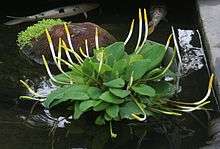Orontium aquaticum
| Orontium aquaticum | |
|---|---|
 | |
| Scientific classification | |
| Kingdom: | Plantae |
| (unranked): | Angiosperms |
| (unranked): | Monocots |
| Order: | Alismatales |
| Family: | Araceae |
| Subfamily: | Orontioideae |
| Genus: | Orontium |
| Species: | O. aquaticum |
| Binomial name | |
| Orontium aquaticum L. | |
Orontium aquaticum /ɒˈrɒntiəm/, sometimes called golden-club,[1] floating arum, never-wets or tawkin[2], is a species of flowering plants in the Araceae family. It is the single living species in the genus Orontium, which also contains several extinct species described from fossils.[3] O. aquaticum is endemic to the eastern United States[1] and is found growing in ponds, streams, and shallow lakes. It prefers an acidic environment. The leaves are pointed and oval with a water repellent surface. The inflorescence is most notable for having an extremely small almost indistinguishable sheath surrounding the spadix. Very early in the flowering this green sheath withers away leaving only the spadix. The sheath was originally classified by Adolf Engler as a spathe due it being the last foliar piece before the spadix.[4] He also noted that species lacked a sympodial leaf. However, in a 1988 paper by Thomas Ray, he argued that the structure was misidentified by Engler and was actually a sympodial leaf. According to Ray the spathe was missing and not the sympodial leaf. This interpretation was determined based on observations of morphological charactestics namely the appearance of a two-keeled bracteole and its positioning.[5] Despite this, the floral structure is still commonly identified in the literature as being a spathe.[6][7][8] The flowering occurs in the spring. Native Americans once ate the seeds and rhizome by drying them out and grinding them into a starchy substance.
Notes
- 1 2 1. Orontium aquaticum Linnaeus, Flora of North America
- ↑ The Royal Horticultural Society 2017, Orontium aquaticum (Golden club )
- ↑ Bogner, J.; Johnson, K. R.; Kvacek, Z.; Upchurch, G. R. (2007). "New fossil leaves of Araceae from the Late Cretaceous and Paleogene of western North America" (PDF). Zitteliana. A (47): 133–147. ISSN 1612-412X.
- ↑ A. Engler, (1887). Vergleichende Untersuchungen uber die morphologischen Verhaltnisse der Araceae. II. Theil Ueber Blattstellung und Sprossverhaltnisse der Araceae, Nova Acta der Ksl. Leop.-Carol.-Deutschen Akademie der Naturforscher 39: 158-231.
- ↑ T.S. Ray, (1988). Survey of Shoot Organization in the Araceae, American Journal of Botany, Vol. 75, No. 1
- ↑ Z. Nie, H. Sun, H. Li, and J. Wen, (2006) Intercontinental biogeography of subfamily Orontioideae (Symplocarpus, Lysichiton, and Orontium) of Araceae in eastern Asia and North America, Molecular Phylogenetics and Evolution 40 (2006) 155–165
- ↑ L.H. Klotz, (1992). On the biology of Orontium aquaticum L. (Araceae), golden club or floating arum, Aroideana 15, 25–33.
- ↑ Simon J. Mayo, Josef Bogner, Peter C. Boyce: The Genera of Araceae. 1. published, Royal Botanic Gardens/ Kew Publishing, London 1997, ISBN 1-900347-22-9 (Full-text as PDF-file; Continental Printing, Belgium 1997).
References
- Bown, Deni (2000). Aroids: Plants of the Arum Family [ILLUSTRATED]. Timber Press. ISBN 0-88192-485-7

